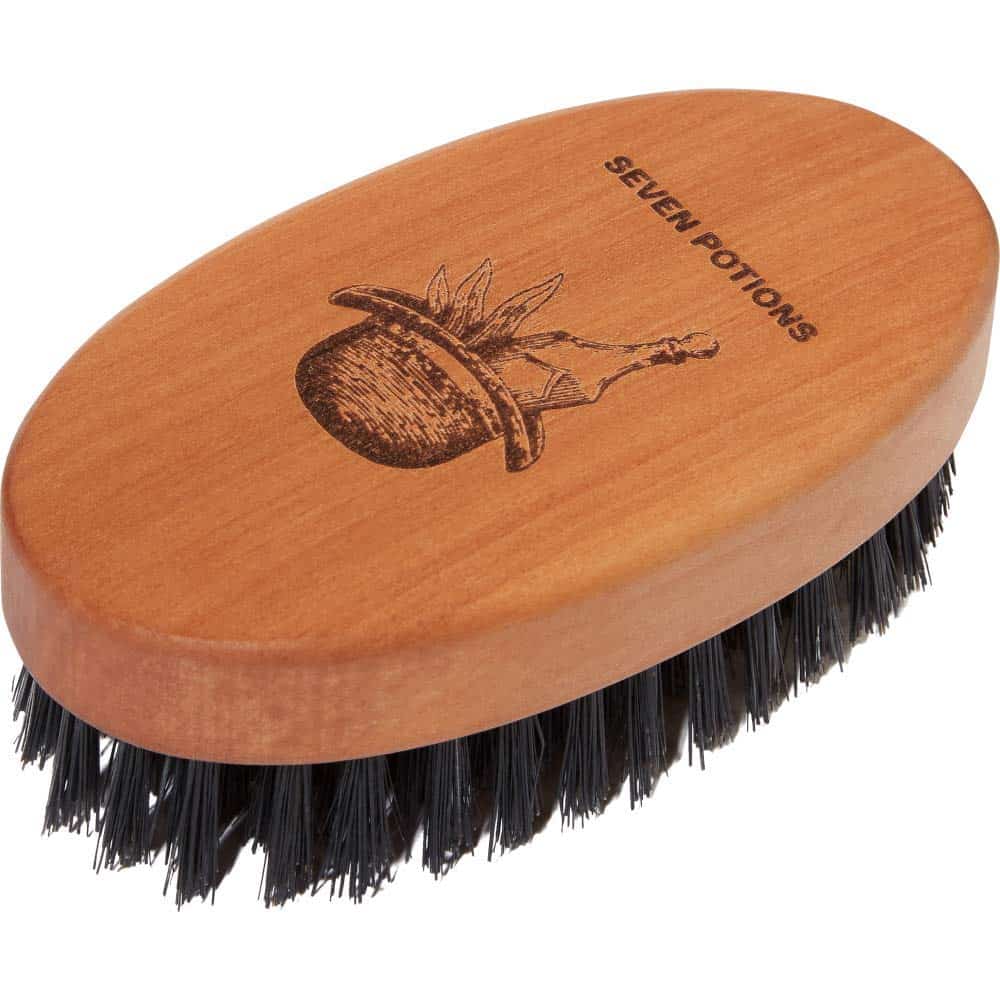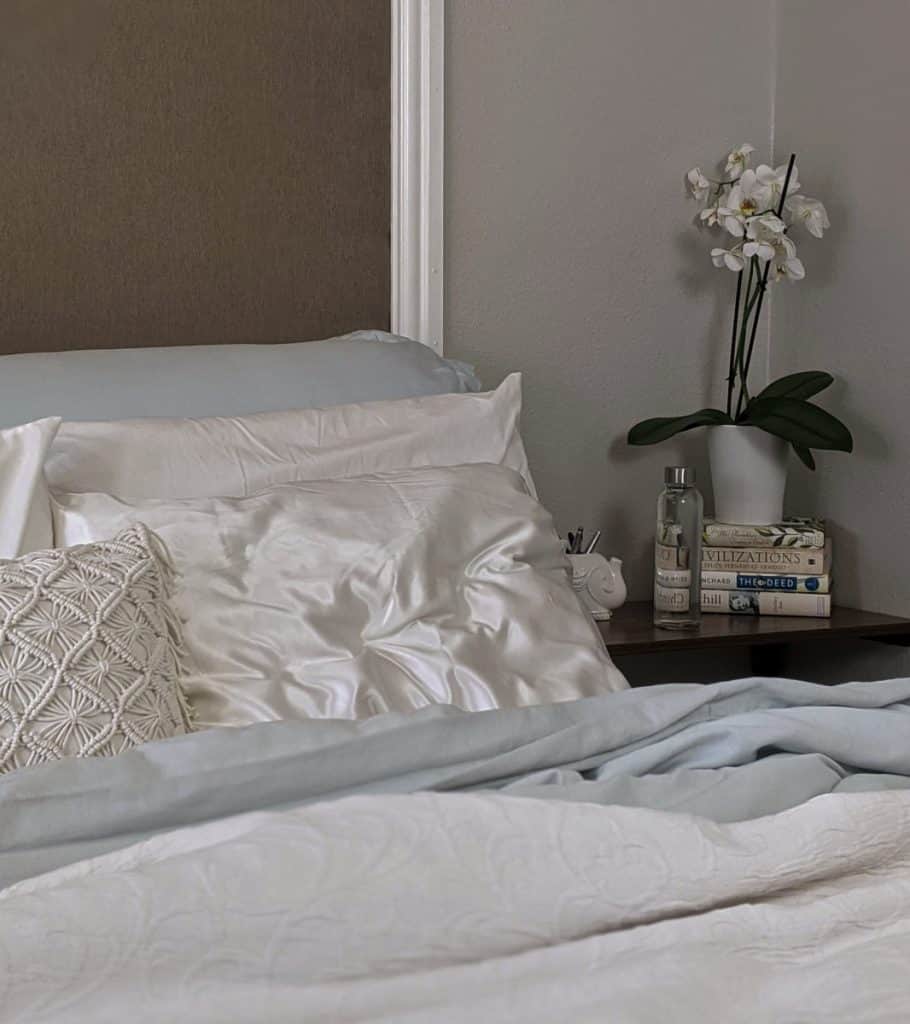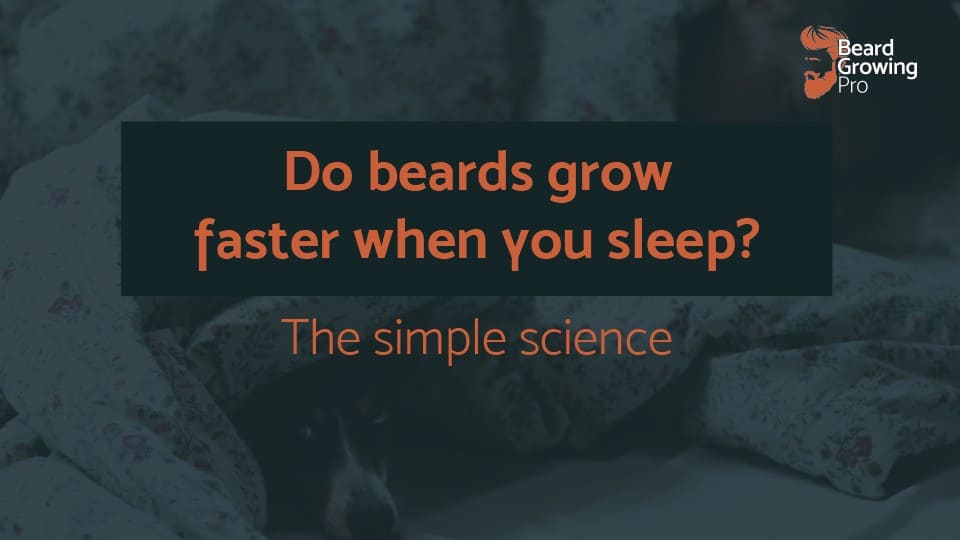When most of us think of beard routines we often think of all of the stuff that we do type beard in the morning. However, preparing your beard for nighttime is also very important. That is because nighttime you are putting a fair amount of pressure on your beard as it smashes against your pillow. We need to make sure that your beard has the best opportunity of surviving whatever you put it through while you are sleeping and the products that we use are not simply wiped off onto your pillow.
A great nighttime beard routine includes brushing and fully drying the hair – since wet hair is much easier to break – using a long-lasting conditioner such as beard oil or beard butter and then protecting the beard using a beard wrap or Satin pillowcase for minimum friction.
I have put together the best nighttime beard advice which I have personally used for many years in order to keep my beard looking its best and ensuring that I don’t simply break or damage the hairs while I am sleeping.
Here are the essential components of a nighttime beard routine. Feel free to use this as a scaffold for crafting your beard routine.
Article Contents
The components of a nighttime beard routine
There are some pillars of a nighttime beard routine that you really shouldn’t change this includes washing your hair (if you shower before going to bed), making sure that your hair is completely dry using a microfibre towel or a medium heat hairdryer, using a leave-in conditioner such as beard oil, coconut oil, or beard butter, brushing your beard, and then ultimately protecting the beard while sleeping.
Here is a rundown on each of these in more detail.
Washing
If I shower before bed I make sure that my beard is as clean as possible. I do not recommend cleaning your beard with shampoo every day as it can easily dry out the oils that are produced by your skin. People who work in a dusty or dirty environment may have to wash their beard every evening but it should be overcome by using the products that I will talk about later on in this article.
While you are washing your beard hair try not to use overly warm water. The extreme heat, whilst feeling incredibly relaxing, can help water penetrate deep into your beard which means that it is much easier to break while you are sleeping on it.
Make sure that you are using a dedicated beard shampoo. A dedicated beard shampoo has been specifically formulated for the conditions on the face. A head shampoo is designed for a much more oily place – your scalp – and so can easily strip too many of the natural oils from your beard.
If you want a full rundown on the best beard wash check out my 50-50 beard experiment using beard brand and honest Amish beard washes:
Drying
One of the most important aspects of a nighttime beard routine is making sure that your beard is as dry as possible. That is because beard hair is particularly prone to damage when it is wet.
In general, hair is incredibly strong. On average a single strand of hair can carry up to 100 g of weight. You can even test this by doing your own experiment outlined in this scientific American article. Hair is strong because it has a three-layered structure. There are keratin fibres that make up the middle layer of the hair strand which is the same stuff that your fingernails are made of.
Although beard hair is incredibly strong there is an important exception to this rule – when your hair is wet.
Wet hair is far weaker than dry hair, which makes it more susceptible to being broken than just about anything else you can do with it. Pulling on the hair strands are more likely to damage wet hair than dry hair.
Why is wet hair weaker than dry hair?
Hair is comprised of protein created in the hair follicle. In the middle of the hair are proteins called keratin and they are covered in cuticles which is like a protective covering for the middle of the hair. When hair is wet it absorbs the water and swells. This interrupts the bonds in the hair making it easier to damage.
As the hair is stretched (through movements of your face on your pillow) the stretching deforms the outer protective layer causing the cuticle edges to lift up and break stop once it’s cuticle armour is damaged it can make the beard feel rough and more wiry.
This means you should take extra care of your hair when it is wet.
You should try your beard hair as thoroughly as possible. You can do this by using a microfibre towel combined with a blow dryer on medium or high heat. I check how dry my beard is at the root by using a cold setting on the hairdryer – this means that I am able to feel the evaporation of the water from the roots of the hair. If I feel any coldness I keep going until the sensation of the water evaporating no longer exists.
I also like to let my hair air dry for a few minutes before putting any oil or butter into my hair. This make sure that my beard is as free of moisture – on the outside – as possible before I go to bed.
This will make sure that your beard is as dry as possible before you put it through all sorts of hassle while you are sleeping.
Conditioning
After your hair is clean and dry you should consider using a leave in and long acting conditioner. For bearded people this is typically a beard oil, a single ingredient such as coconut oil or sheer butter or a beard butter. One of the most important things is that you do not use a product with a hold component – such as beeswax.
Oil
One of the best options for your beard when you are going to sleep is a beard oil. Beard oils are very common and are used to reduce dryness in the hair and skin. Beard oils typically contain a carrier oil (which is the majority component) and an essential oil). I would recommend staying away from a beard oil that contains a lot of jojoba oil. Jojoba oil is not easily absorbed into the hair and will set against the beard for a long time before being absorbed.
Consider buying a beard oil that contains Argan oil and sweet almond oil – these are much more readily absorbed into the beard hair and with prolonged exposure, like overnight, will penetrate deeply into the core of the hair fibres.
You can also choose to use a single ingredient such as coconut oil.
Coconut oil
A study published in 2012 called Quantitative measurement of the penetration of coconut oil into human hair using radiolabeled coconut oil looked at the science behind the penetration of coconut oil into hair.
Applying coconut oil to hair has been used for centuries particularly in Asian and African countries and it is the fact that the oil stops water penetrating into the hair to cause swelling and breakages which results in the main protection mechanism.
The scientists looked at the absorption of the coconut oil into the human hair by using a small radioactive component (tritium) in the coconut oil. 10 cm long strands of Indian hair was soaked in 1.5 mL of the coconut oil which had been radiolabelled.
The method was able to distinguish between surface deposited oil and oil that had been absorbed directly into the hair fibre. It was found that the oil was deposited mainly on the surface of the hair but also was able to penetrate the hair fibre.
To use coconut oil effectively you have to make sure that you give enough time to penetrate into the core of the hair and you do that by heating it up so that it becomes easy to apply to the hair and leave it for at least 20 minutes after application.
Butter
The last ingredient that you should consider putting on your beard before bed is a butter. You can purchase a dedicated beard butter that has been manufactured to include a range of different butters such as Shea butter or cocoa butter.
One of my favourite buses is sheer butter as it has a wide range of important benefits for beards and you can find beard butters where the majority component is sheer butter. However, if you just want to use it on your own – which you can – it can be one of the best things to put in your beard right before bed.
Shea butter is a fantastic product that is amazing for each and every part of your beard growing journey. I have been using Shea butter for as long as I have been grown beard – even when I had stubble – and I always keep a fresh batch on hand for when I want to give my skin and beard that extra boost.

Shea butter has an amazing array of properties that are completely backed up by science:
- It can help you beat beardruff – In 2018 a study found that when used in combination with other products it helps reduce flakes.
- It may help hair get stronger – Similar plant-based butter has been shown to make hair much more resistant to breakages
- It is antibacterial and antifungal – if your beard is smelling or you have some issues with a dirty beard. Shea butter will help fight off the bacteria that are in your beard. Want more about beard bacteria? Check out this article all about beard bacteria.
Do not use balm or wax!
One thing that I would advise against is putting in a beard balm or a beard wax. This is because both of these types of products contain beeswax. There is no point in using beeswax before you are going to bed. Beeswax is added to beard products in order to provide hold and long-lasting styling throughout the day. If you use in your beard at night it will simply sit against your beard and could act as a barrier for quick absorption of the Shea butter or oils that you have so carefully placed into your beard.
Brushing
After applying your beard oil, coconut oil, or butter you should brush the hair from root to tips. I typically use a two-stage process while brushing my beard.

- Firstly, I use a wide tooth comb to brush and comb the full depth of the beard. This comb should be made of wood or machined plastic in order to protect the cuticles of the hair from becoming damaged through over brushing. I really recommend the Kent fine tooth beard comb as it is sawcut and is made from a low static material.
- Secondly, I used a natural hair brush to lightly brush the top of the beard. This provides a number of benefits including detangling the hair but, more importantly, can act as a way of further distributing the beard product throughout the hair. One of the best natural hair beard brushes at the moment is the ZilberHaar Beard Brush.
Remember that you should always be very careful when brushing your beard as it is one of the easiest ways to damage it.
Protecting the beard
When you go to bed you should aim to protect the beard as much as possible. You can buy a separate cover such as a beard wrap or you can make sure that the hair is not put under a huge amount of strain by covering your pillow with a silk or satin pillowcase.
Beard wrap
Beard wraps are also called beard bandannas, beard durags, beard bonnets, beard guards, and beard rags. They are becoming increasingly popular to wear at night by bearded people all over the world. They are an excellent way to protect your beard while sleeping and they are the only dedicated beard product on this list that could actually help you protect your beard as you sleep.

When you are looking to purchase a beard wrap you have to make sure that it is super comfortable and will not add any extra damage or risk of damage to your beard. You can do that by checking the following things:
- material – the material that beard wrap is made of is very important. Quite often the beard wraps are made of a double layered construction with a satin or silk layer on the inside. Satin or silk is the best option for most uses as it also allows you to wear beard oil while sleeping.
- Size – if you have a really long beard you need to make sure that you buy a beard wrap that is big enough to hold your entire beard without putting too much pressure on it. Beard wraps come in a variety of sizes and so measure from one into the other taken in the full shape of the beard and choose one that will comfortably accommodate the full bulk of your beard.
- Attachment type – most beard wraps use and over the ear attachment method this can be relatively uncomfortable for many people as you do not want your ears being tugged on all night long. No matter how comfortable or soft the elastic is it can be very frustrating. There are other options such as over the head and neck attachment types – so choose one that is best for you.
A beard wrap can also be made with any sort of satin or silk like material. You can tie around your face like a bandanna and although it may not be as comfortable as a commercially available one it will still do the trick of protecting your beard.
Choose your beard wrap wisely and focus on comfort.
Satin/Silk pillow
A silk pillow will minimise the amount of friction that is caused during your tossing and turning at night and will be a frictionless surface so your hairs can move around with your movements.

The thing is, is that beard hairs can easily become trapped between you and your pillow.
You can end up putting a fair bit of torsional strain right at the base of the hair and causing it to become weakened.
If you do this night after night you may find that more hairs are falling out than usual.
Silk pillowcases are good for your skin as well as your facial hair. It does not strip your face or skin of the natural oils like cotton can. You shouldn’t use a silk pillowcase in combination with beard oil because it will end up all over the bed. If you want to know more about using beard oil at night check out my other article where I talk about whether or not applying beard oil before bed is a waste of time and money – click here.
Silk pillowcases have all of these benefits:
- They help prevent frizzy hair – because of silt super smooth texture the hair glides over it without any friction which means that it’ll not be as frizzy in the morning.
- They keep skin hydrated – silt smoothness means that it is less likely to absorb moisture from your skin which keeps the moisture where it can do the best – next to your skin.
- Keeps hair healthy – if you have particularly brittle beard hair silk can help. Cotton is much more porous than sink and so traditional pillowcases absorb the moisture from your hair. That means if you suffer from dry hair all you have beard dandruff a good silk pillowcase will really help.
If you do not want to purchase a dedicated silk pillowcase you can also buy the material or use a cheap silk scarf on your pillow. You will need to find out some way to keep it in position throughout the night maybe with some clips on the underside of the pillow. But it is a cheap and effective way to try out the benefits of a silk pillow without spending loads of money on one initially.
How should I sleep with a beard?
If you are a stomach or side sleeper you may be putting a lot of pressure on your beard.
One of the easiest ways to overcome putting pressure on your beard is to become a back sleeper.
If you want to sleep on your back there are a number of ways to make sure that you end up there. The easiest way is to put a pillow on either side of yourself so that you can secure your sleeping position. A good head pillow for sleeping on your back is something that is of a medium loft and softness because if it is too high you probably end up putting your neck into an uncomfortable position.
Is it bad to sleep on your beard?
It is not bad to sleep on your beard hair as long as you take precautions such as wearing a beard cover or by using a low friction pillowcase such as silk or satin.
It is unlikely to cause any significant issues to blood flow to the hair roots while you are sleeping. That is because the pillow is very soft and is unlikely to cause enough pressure to squeeze the microscopic capillaries that supply the blood to the base of the hair.
Does sleep increase beard growth?

Ultimately, beards have not been proven to grow faster at night or why you are sleeping. The rate of your beard growth is directly correlated with your metabolism and there are few metabolic studies that have looked at the rate of peoples metabolism while they’re sleeping and find that it is highest when there is rapid eye movement sleep.
If you want your beard to grow faster all you have to do is make sure you get a good nights sleep. Sleep deprivation can result in a disruption to your hormonal system which can impact your testosterone and therefore the amount of hair that is grown on your face.
Summary
In this article, we have covered the ultimate nighttime routine and looked at the main components of making sure your beard is nourished and protected while you are sleeping.
The most important aspect is that your beard is as dry and protected as possible. Studies have shown that wet hair is easier to break than dry hair and you should try to stop any extra strain on your beard by using a beard wrap while you are sleeping or using a satin or silk pillowcase.
This is how you end up with the ultimate nighttime beard routine!



